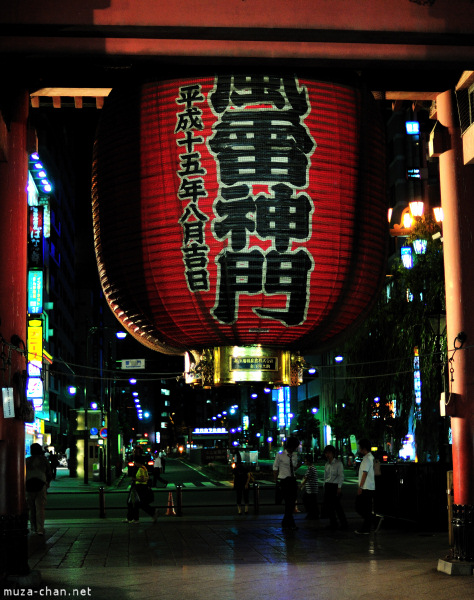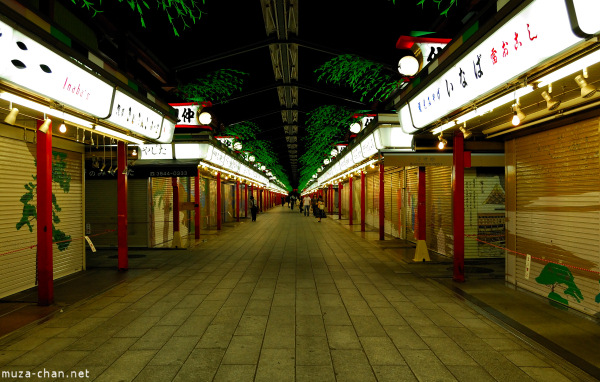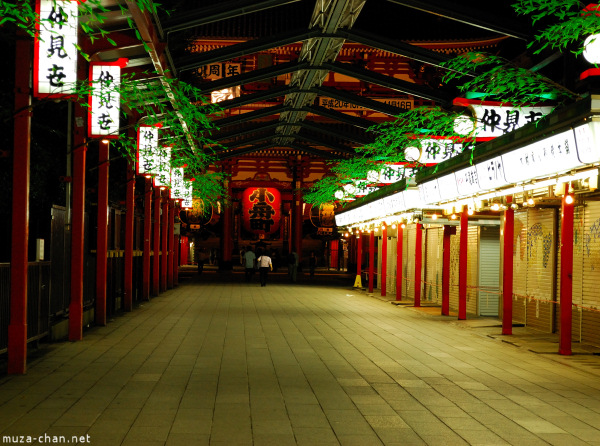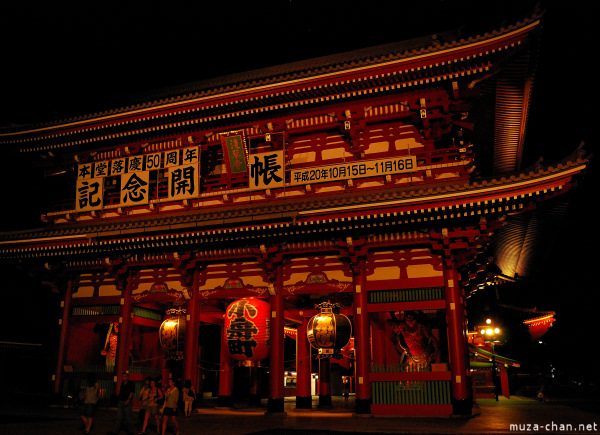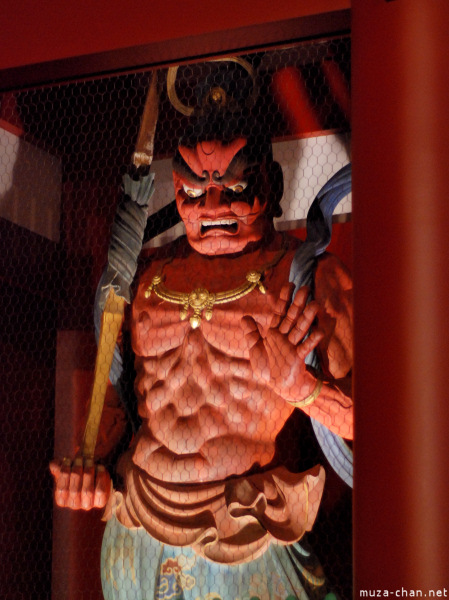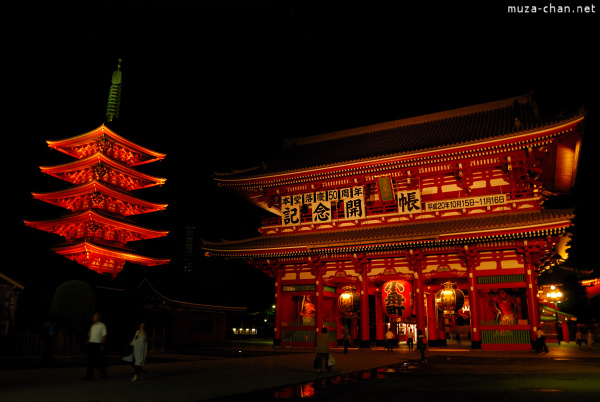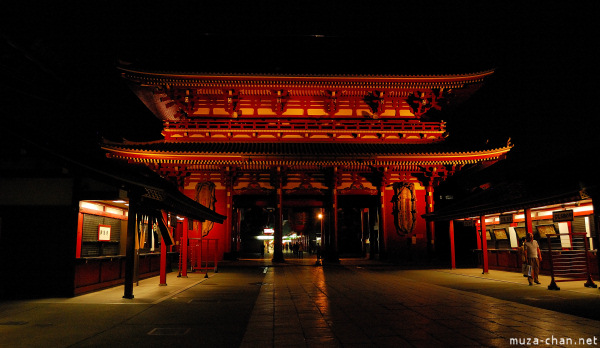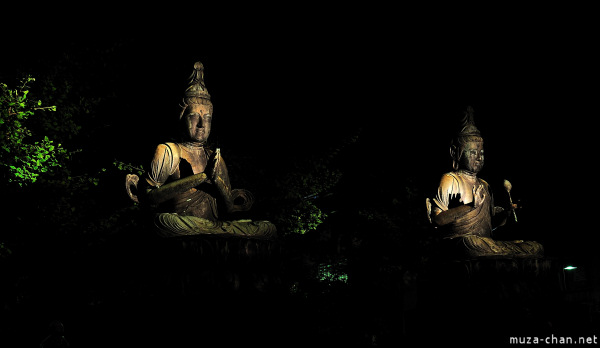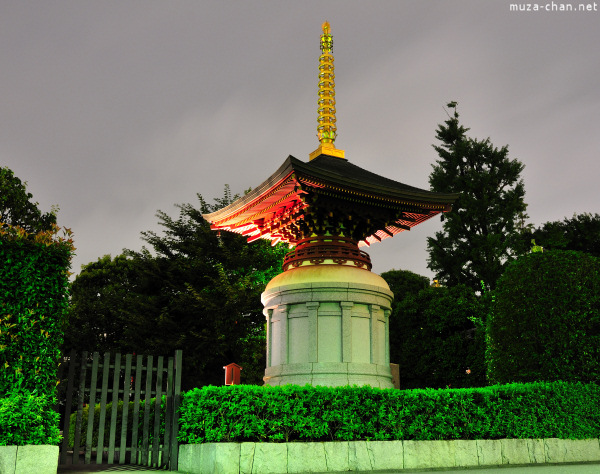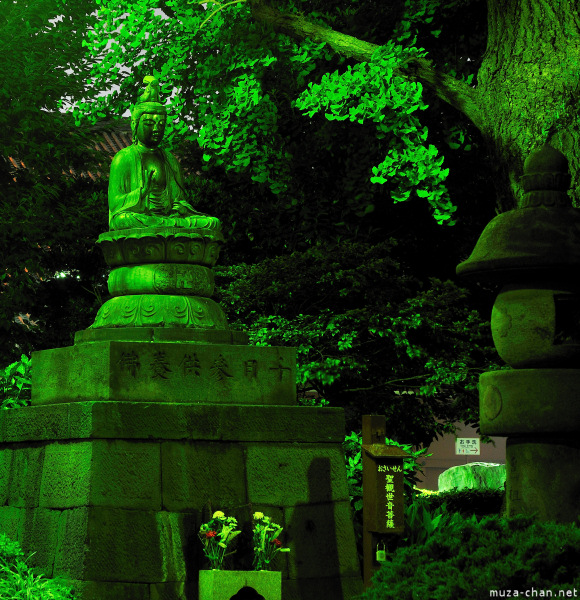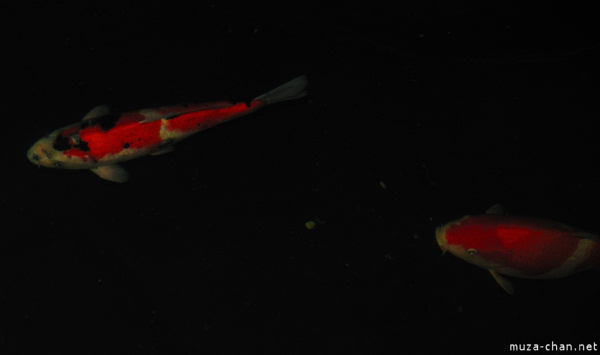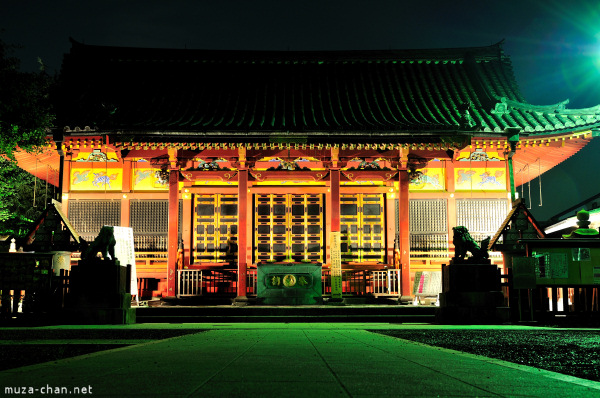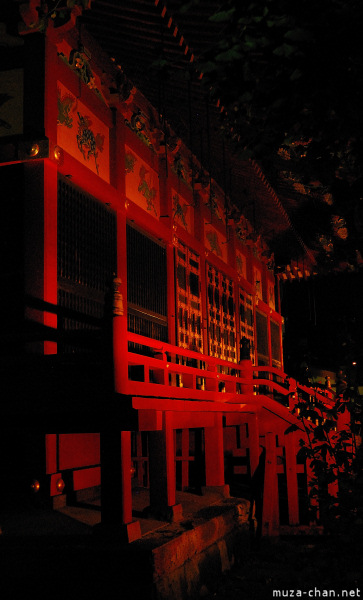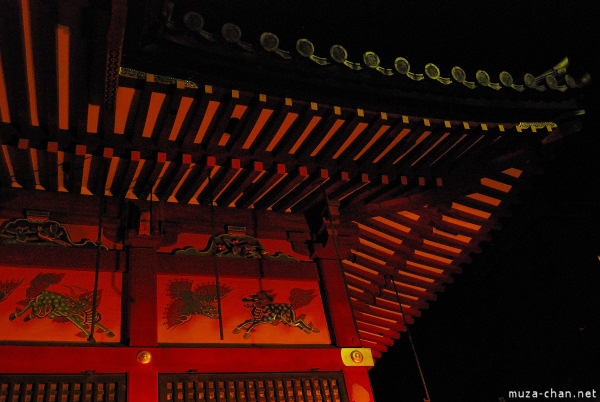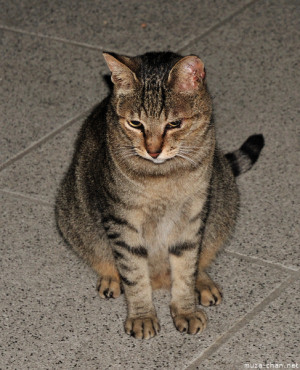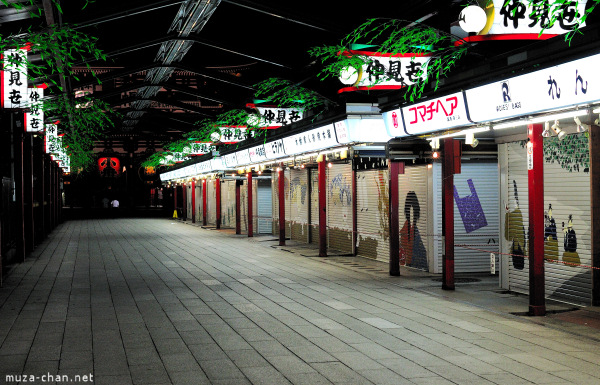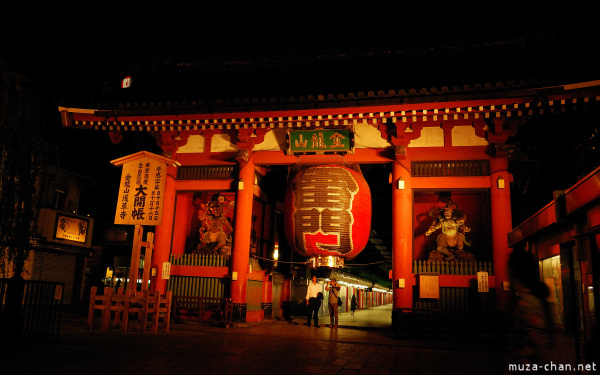During my first visit in Tokyo, I stayed at a hotel in Asakusa. Arriving early, after I left my luggage at reception, until the hour when I could check-in the room, I took a walk in the area, eager to see the places I have read about. And the first place I visited was the Senso-ji complex, the oldest temple in Tokyo. I enjoyed it so much that the next year, when I returned, I repeated the experience. Only after the stroll through these lovely places, I had the feeling that I returned.
Because of that, in the last evening in Tokyo, no matter how tired I am and regardless of weather, I walk again to Senso-ji, to say farewell.
Last year, on my last night in Tokyo, a warm night of July, with the sky almost clear and a mysterious full moon, I took my camera and the tripod and went to take night pictures at Senso-ji.
During the day, in front of Kaminarimon gate it’s always crowded: people waiting, tourists entering and exiting the Nakamise street, athletic boys offering rickshaw services or promoters offering all kind of leaflets. Now, in the night, there where very few people, some waiting in front of the gate and some hurrying through the walkway, wrapped up in thoughts. But there where some, even the hurried ones, briefly stopping in front of the gate and taking pictures with their phones.
The shops from Nakamise where closed, all the roller blinds shut, just the sweet scent lingering reminded me of the goodies prepared here during the day.
On the Nakamise street I met some passersby, mostly salarymen, alone or in noisy small groups, tired looking schoolgirls and boys and, rarely, some lovers, hand-in-hand.
At the end of the shops rows, the Hozomon gate stopped me for a few photos, with it’s three lanterns reflecting golden light.
In the semi-darkness, the two red Nio statues (The Two Deva Kings) with their expressive gaze, seemed cold and menacing. But that’s the way they’re supposed to look, they have to guard the gate so the evil spirits won’t pass…
By contrast, the tall five-story pagoda from the left, bathed in golden light, seemed to warm the air.
I passed Hozomon and admired the decorations, especially the two 4.5-meter giant sized straw sandals (waraji).
In front of the shops selling omikuji and omamori, also closed, there was nobody. Arriving in front of the main building of Senso-ji, the air still filled with the incense smoke gave me a strange, intimate feeling, because at home I frequently burn incense.
I was suddenly awoken from my dreams by the hard sound of the bell and the coins thrown into the wooden offering box (saisen bako) by several worshipers, followed by the two familiar clappings.
This reminds me that since I learned how to pray Shinto style (thanks, Naoki) I was always impressed by the simplicity of the ritual. I sensed the divinity close, I felt protected.
I walked in front of the temple, near the two big Buddha statues, Bodisattva Avalokiteshvara and Bodisattva Seshi. Several lights from the area where casting beautiful light rays on the bronze statues, so I put my camera on the tripod and took several pictures, with a constant feeling that the statues where watching me.
On the left side of the main building, near a Shakyo pagoda, where there’s a garden with a small brook, plants and rocks, there was no light.
I entered, and near the Buddha statue, surrounded by greenery, lighted only by the moon, I had a true feeling of tranquility, like in a poem:
“There’s so much serenity around me that I can hear
the moon light striking the windows” - Lucian Blaga
I stood still several minutes, just me, the statue and a few koi swimming in the dark water.
I crossed again by the front of the temple, near two lovers sitting hand-in-hand on the staircase in the dark. I reached the Shinto shrine, my favorite place in the Senso-ji complex. Near the red shrine building, the two bronze koma inu greeted me, looking friendly.
I seated quietly near the shrines wall, admiring the ornaments with fantasy animals…
In the dark, thinking about those dragons and fantastic creatures, something moved close to me and startled me.
It was a cat, probably the shrine’s neko. She came next to me and started watching me. I called her, she came closer and let me caress her.
She purred a little and left me, but remained close. Maybe it was a kami…
I departed toward my hotel, covering again the Nakamise street, now even emptier. Behind me, someone started shutting the lights off and at one moment, when I looked behind me, the Hozomon gate was now immersed in darkness.
I stopped again in the from of Kaminarimon gate, amused by two Japanese boys taking pictures with the gate, with the mobile phones. They tried several times, study the results and noddign, contented, left the scenery smiling and humming… And I was carrying all that heavy photo equipment with me…
Good Bye, Senso-ji, I will come back next year.
For more photos from Senso-ji and Asakusa Shrine, visit the Photo Gallery.
La prima vizită în Tokyo m-am cazat la un hotel din Asakusa. Sosind devreme, după ce mi-am lăsat bagajele la recepţie, până la ora când am putut să-mi iau în primire camera, m-am plimbat prin zonă, nerăbdătoare să văd locurile despre care citisem. Iar primul loc pe care l-am vizitat a fost complexul de la Senso-ji, cel mai vechi templu din Tokyo. Mi-a plăcut atât de mult, încât anul următor, când am revenit, am repetat experienţa. Abia după plimbarea prin locurile atât de dragi, am avut sentimentul că am revenit.
În ultima seară din Tokyo, oricât de obosită aş fi şi indiferent de vreme, merg din nou la Senso-ji, să-mi iau la revedere.
Anul trecut, în ultima seară din Tokyo, o seară caldă de iulie, cu cer aproape senin şi cu o misterioasă lună plină, mi-am luat aparatul şi trepiedul şi m-am dus să fac fotografii de noapte la Senso-ji.
În timpul zilei, în faţa porţii Kaminarimon este tot timpul aglomerat: oameni care aşteaptă, cei care intră şi ies de pe strada Nakamise, băieţii atletici care te invită la o plimbare cu ricşa sau cei care împart pliante cu reclame. Acum, noaptea, erau destul de puţini oameni, unii aşteptau în faţa porţii, alţii treceau grăbiţi pe trotuar, unii preocupaţi, adânciţi în gânduri, fără să se uite în jur, iar alţii care aruncau o privire scurtă spre poarta templului sau chiar se opreau pentru a face o fotografie cu telefonul mobil.
Magazinele din bazarul de pe strada Nakamise erau închise de ceva vreme, toate storurile erau trase, doar mirosul de dulciuri lăsat în urmă mai amintea de bunătăţile care se prepară aici.
Pe strada lungă, m-am întâlnit cu câţiva trecători, care mergeau spre templu sau de la templu, unii singuri, alţii în grupuri: salaryman în grupuri de 3-4, care discutau gălăgios, elevi în uniforme, care arătau destul de obosiţi sau îndrăgostiţi care se ţineau delicat de mână.
La ieşirea de pe culoarul cu magazine, m-a întâmpinat poarta Hozomon, cu cele trei felinare pe care se reflecta o lumină aurie.
În semiîntuneric, cele două statui ale Nio (The Two Deva Kings), de culoare roşie, cu privirea expresivă, mi-au părut reci, ameninţătoare. Aşa şi trebuie, sunt gardienii porţii, care nu lasă să treacă spiritele rele.
În opoziţie, pagoda cu cinci etaje situată în stânga, înaltă de 64 de metri, scăldată într-o lumină galbenă, mi s-a părut caldă.
Am trecut dincolo de poarta Hozomon şi am admirat decoraţiile de pe această parte, cele două sandale împletite din paie (waraji), de 4.5 m lungime, croite pe măsura unui uriaş.
În faţa magazinelor care vând omikuji şi omamori, acum cu storurile trase, era pustiu. Ajunsă în faţa clădirii principale a templului Senso-ji, aerul îmbibat de fumul de la beţişoarele parfumate care se ard continuu în timpul zilei mi-a dat o impresie de familiaritate, pentru că acasă, am obiceiul să ard esenţe parfumate.
Deodată, m-a trezit din visare sunetul clopotului şi zornăitul monezilor aruncate de câţiva oameni în cutia din lemn (saisen bako) din faţa templului, urmate de cele două bătăi din palme. Ritualul m-a impresionat întotdeauna prin simplitate şi bun gust. Şi de data aceasta, am simţit divinitatea aproape, m-am simţit protejată.
M-am plimbat prin faţa templului, pe lângă cele două mari statui care îi reprezintă pe Bodisattva Avalokiteshvara şi pe Bodisattva Seshi. Câteva becuri aprinse în acea zonă trimiteau raze de lumină care se reflectau pe statuile din bronz, verdeaţa din jur rămânând în penumbră. Mi-am pus aparatul pe trepied, am făcut fotografii din câteva unghiuri, având tot timpul impresia că cele două statui mă privesc.
În zona din stânga clădirii principale, lânga Shakyo pagoda, unde este amenajată o grădină, cu un pârâu, plante şi stânci, era întuneric deplin.
Lângă statuia lui Buddha, înconjurată de verdeaţă, luminată doar de razele lunii pline, am avut cu adevărat un sentiment de linişte, ca în versurile lui Lucian Blaga:
“Atâta linişte-i în jur de-mi pare că aud
cum se izbesc de geamuri razele de lună”
Am stat nemişcată câteva minute, doar eu, statuia şi cei câţiva koi care înnotau în întuneric.
Am traversat din nou prin faţa clădirii principale a templului budist, pe lângă doi îndrăgostiţi care stăteau pe scară, în semiîntuneric, ţinându-se de mână. Am ajuns lângă altarul shinto, locul meu preferat din complexul de la Senso-ji. Lângă clădirea pictată în roşu, m-au întâmpinat cei doi koma inu, din bronz, care mi s-au părut prietenoşi.
M-am aşezat foarte aproape de peretele altarului, privind cu atenţie ornamentele cu animale fantastice…
… cu capete de dragoni, unele cu aripi, altele cu picioare cu copite. În semiîntuneric, mi s-a părut că le simt lângă mine, că le aud zburând prin aer, în jurul templului.
Deodată, am văzut ceva mişcând în întuneric, foarte aproape de mine şi m-am înfiorat. Era o pisică, neko a altarului probabil, care a venit şi a început să mă privească. Am chemat-o la mine, a venit şi m-a lăsat s-o mângâi.
A tors un pic şi după aceea a plecat de lânga mine, dar nu s-a îndepărtat prea mult. M-am gândit că e probabil un kami…
Am plecat spre hotel, parcurgând în sens opus strada Nakamise, acum şi mai goală ca la venire. În urma mea, cineva a început să stingă luminile, una câte una, iar la un moment dat, cand m-am uitat în urmă, am văzut poarta Hozomon cufundată în întuneric.
Am stat puţin în faţa porţii Kaminarimon, amuzându-mă de doi japonezi care făceau fotografii cu telefonul mobil, în faţa porţii. Au făcut câteva fotografii, apoi s-au uitat la ele, păreau mulţumiţi, au dat din cap, au râs şi au plecat. Şi eu care duceam un echipament atât de greu…
La revedere Senso-ji, ne revedem la anul!
Pentru mai multe fotografii de la Senso-ji, vizitaţi galeria foto.
